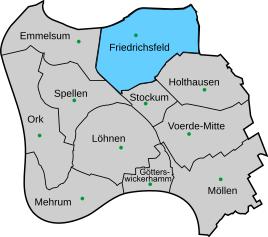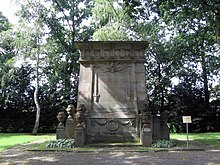Friedrichsfeld (Lower Rhine)
|
Friedrichsfeld
City of Voerde (Niederrhein)
|
|
|---|---|
| Coordinates: 51 ° 37 ′ 37 ″ N , 6 ° 39 ′ 17 ″ E | |
| Height : | 26 m |
| Area : | 7.69 km² |
| Residents : | 11,409 (December 31, 2014) |
| Population density : | 1,484 inhabitants / km² |
| Postal code : | 46562 |
| Area code : | 0281 |
|
Location of Friedrichsfeld in Voerde (Niederrhein)
|
|
Friedrichsfeld is the youngest part of the city of Voerde (Niederrhein) in the Wesel district in North Rhine-Westphalia and has 11,409 inhabitants. The place was part of the municipality Spellen until 1922 and was officially called "Oberemmelsum". In addition to the Protestant and Catholic parishes, the Sultan Ahmet mosque and the New Apostolic congregation contribute to religious diversity. The Wesel-Datteln Canal is the border to Wesel , in which the Friedrichsfelder Schleuse is located, which geographically, however, belongs to the district of Emmelsum. Friedrichsfeld also owns the Voerde grammar school and a primary school ( community elementary school Friedrichsfeld primary school ).
Although Friedrichsfeld is a very small town on the border of the northern Ruhr area , there are relatively many shopping opportunities here. There are numerous bakeries, many restaurants and fast food restaurants as well as supermarkets here. The volunteer fire brigade exists as well as all kinds of small businesses.
The most important road is the B 8 (Hindenburgstrasse) , which runs from south to north . By the breakpoint Friedrich field (Lower Rhine) , the place is on the Oberhausen-Arnhem railway to the SPNV connected, so that for example the (near airport Dusseldorf can be reached) to the train in 40 minutes. The Niederrhein Airport is reached by car in about 45 minutes.
The connection to the autobahn is via the A 3 (exit Hünxe) or the A 59 (exit Dinslaken-West).
An industrial company of supraregional importance is Winergy AG , a subsidiary of the Bocholt gear specialist Flender GmbH . According to its own information, it is the world's largest manufacturer of gearboxes for wind turbines and has been part of the Siemens Group since July 2006 .
history
Geologically, the settlement site is on a glacial lower terrace by Sander of the terminal moraine tester mountains at Hünxe coined whose former glacial sand-rich meltwater into the glacial valley drained by the day of the Rhine flows. After the Ice Age, nutrient-poor soils formed on the silicate-rich substrates, while fertile floodplains were created on the Rhine and Lippe , which were primarily settled. Today's Friedrichsfeld settlement is located in the western part of the former Spellner Heide , which was part of the farming village of Spellen , which has existed since 777 as a hat, forest and hunting ground . In the 18th century , the approximately 1,000 hectare area of today's district served as a military training area for Frederick the Great's troops stationed in Wesel . After the death of Frederick the Great in 1786, the number of troops in Prussia was reduced. In 1794 the area was occupied by French troops. It was not until 1815 that the occupation ended as a result of the Wars of Liberation . With the introduction of conscription in Prussia, the municipality of Spellen also became the shooting range of the 7th Westphalian Artillery Brigade . The area was not very suitable for agricultural intensification and offered good conditions for a military training area. It was only sparsely populated and only in the area of today's town center was there a farm, the "Hofgut Friedrichsfeld". The name is based on him in honor of Friedrich.
In the coming decades the city of Voerde was supposed to provide accommodation for the soldiers who only use the area in the summer months. The remuneration paid was not considered sufficient and the circumstances often led to disputes. Around 1865 the "Hofgut Friedrichsfeld" ran into financial difficulties. The then mayor Karl von der Mark bought the farm privately. On the 47 hectare area he had a house built to accommodate the officers. This was inaugurated on July 16, 1870 and, together with the entire training area, was given the name "Friedrichsfeld" by General von Decker, commander of the 7th Artillery Brigade. The name thus became official. In the administration, however, the name "Oberemmelsum" was still used, as a district of the municipality of Spellen, which was independent until 1922.
During the celebrations for the building of the house, General von Decker received a courier order to mobilize because France had declared war on Prussia on July 19, 1870. As a result of the Franco-Prussian War , numerous French prisoners of war had to be housed in Wesel and Friedrichsfeld. The mayor of Voerde offered the Prussian state his farm for sale, on which the "Friedrichsfeld military camp" was built. Numerous buildings were erected for this. French prisoners of war lived in the camps from autumn 1870 until their return in summer 1871. Of the 10,000 prisoners, 248 died and were buried in the cemetery ("Franzosenfriedhof") built in the east.
After the French returned, the camp remained a military training area for Prussian soldiers until 1920. During the First World War , Friedrichsfeld was again used as a prisoner of war camp for people from different nations, such as Russians, English, Serbs, Italians, Portuguese and Belgians. Separate warehouses were built for this. From 1914 to 1919 620 of the prisoners of war died. In 1916, with the help of the military administration, the prisoners erected the war memorial in the middle of the cemetery . A few years after the war ended, most of the dead were returned to their homeland. The camp was also dissolved and the settlement company for the district of Dinslaken GmbH bought the place in 1921 in order to develop the civil place Friedrichsfeld.
During the Second World War, part of the former military camp was used for civil slave labor from areas occupied by Germany, mainly from Ukraine. The dead from this period were also buried in this cemetery; These include 99 toddlers who were born to forced laborers and most of them died of malnutrition and infections in the winter of 1944/45. In addition, forced laborers who died from the Allied bombing raid on Friedrichsfeld in 1945 were buried. From the time of World War II, 352 dead were buried in the cemetery.
swell
- Karl Göllmann: The emergence of Friedrichsfeld. (PDF; 2.21 MB) In: Werbegemeinschaft Friedrichsfeld eV Archived from the original on April 17, 2012 ; accessed on May 7, 2020 .
- Memorial plaque in the cemetery , put up by the city of Voerde
- Statistical data on voerde.de





